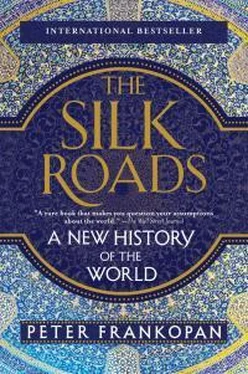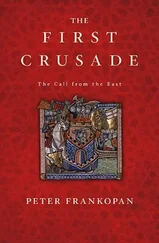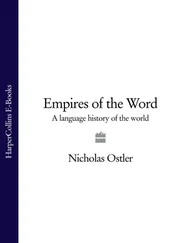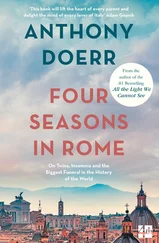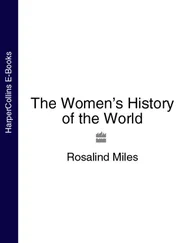The decades that followed Alexander’s death saw a gradual and unmistakable programme of Hellenisation, as ideas, themes and symbols from ancient Greece were introduced to the east. The descendants of his generals remembered their Greek roots and actively emphasised them, for example on the coinage struck in the mints of the major towns that were located in strategically important points along the trade routes or in agriculturally vibrant centres. The form of these coins became standardised: an image of the current ruler on the obverse with ringlets held by a diadem, and invariably looking to the right as Alexander had done, with an image of Apollo on the reverse, identified by Greek letters.23
The Greek language could be heard—and seen—all over Central Asia and the Indus valley. At Ai Khanoum in northern Afghanistan—a new city founded by Seleucus—maxims from Delphi were carved on to a monument, including:
As a child, be well-behaved.
As a youth, be self-controlled.
As an adult, be just.
As an elder, be wise.
As one dying, be without pain.24
Greek was in daily use by officials more than a century after Alexander’s death, as tax receipts and documents relating to soldiers’ pay from Bactria from around 200 BC show.25 Indeed, the language penetrated deep into the Indian subcontinent. Some of the edicts issued by Maurayan ruler Ashoka, the greatest of the early Indian rulers, were made with parallel Greek translations, evidently for the benefit of the local population.26
The vibrancy of the cultural exchange as Europe and Asia collided was astonishing. Statues of the Buddha started to appear only after the cult of Apollo became established in the Gundhara valley and western India. Buddhists felt threatened by the success of new religious practices and began to create their own visual images. Indeed, there is a correlation not only in the date of the earliest statues of the Buddha, but also in their appearance and design: it seems that it was Apollo that provided the template, such was the impact of Greek influences. Hitherto, Buddhists had actively refrained from visual representations; competition now forced them to react, to borrow and to innovate.27
Stone altars adorned with Greek inscriptions, the images of Apollo and exquisite miniature ivories depicting Alexander from what is now southern Tajikistan reveal just how far influences from the west penetrated.28 So too did the impressions of the cultural superiority brought from the Mediterranean. The Greeks in Asia were widely credited in India, for example, for their skill in the sciences: “they are barbarians,” says the text known as the Gārgī Samhitā , “yet the science of astronomy originated with them and for this they must be reverenced like gods.”29
According to Plutarch, Alexander made sure that Greek theology was taught as far away as India, with the result that the gods of Olympus were revered across Asia. Young men in Persia and beyond were brought up reading Homer and “chanting the tragedies of Sophocles and Euripides,” while the Greek language was studied in the Indus valley.30 This may be why it is possible that borrowings can be detected across great works of literature. It has been suggested, for instance, that the Rāmāyaṇa , the great early Sanskrit epic, owes a debt to the Iliad and to the Odyssey , with the theme of the abduction of Lady Sita by Rāvaṇa a direct echo of the elopement of Helen with Paris of Troy. Influences and inspiration flowed in the other direction too, with some scholars arguing that the Aeneid was in turn influenced by Indian texts such as the Mahābhārata. 31 Ideas, themes and stories coursed through the highways, spread by travellers, merchants and pilgrims: Alexander’s conquests paved the way for the broadening of the minds of the populations of the lands he captured, as well as those on the periphery and beyond who came into contact with new ideas, new images and new concepts.
Even cultures on the wild steppes were influenced, as is clear from the exquisite funerary objects buried alongside high-ranking figures found in the Tilya Tepe graves in northern Afghanistan which show artistic influences being drawn from Greece—as well as from Siberia, India and beyond. Luxury objects were traded into the nomad world, in return for livestock and horses, and on occasion as tribute paid in return for peace.32
* * *
The linking up of the steppes into an interlocking and interconnecting world was accelerated by the growing ambitions of China. Under the Han dynasty (206 BC–AD 220), waves of expansion had pushed frontiers ever further, eventually reaching a province then called Xiyu (or “western regions”), but today known as Xinjiang (“new frontierland”). This lay beyond the Gansu corridor, a route 600 miles long linking the Chinese interior with the oasis city of Dunhuang, a crossroads on the edge of the Taklamakan desert. At this point, there was a choice of a northern or a southern route, both of which could be treacherous, which converged at Kashgar, itself set at the junction point of the Himalayas, the Pamir mountains, the Tien Shan range and the Hindu Kush.33
This expansion of China’s horizons linked Asia together. These networks had hitherto been blocked by the Yuezhi and above all the Xiongnu, nomadic tribes who like the Scythians in Central Asia were a source of constant concern but were also important trading partners for livestock: Han authors wrote in the second century BC of tens of thousands of head of cattle being bought from the peoples of the steppes.34 But it was Chinese demand for horses that was all but insatiable, fuelled by the need to keep an effective military force on standby to maintain internal order within China, and to be able to respond to attacks and raids by the Xiongnu or other tribes. Horses from the western region of Xinjiang were highly prized, and could make fortunes for tribal chieftains. On one occasion, a Yuezhi leader traded horses for a large consignment of goods that he then sold on to others, making ten times his investment.35
The most famous and valuable mounts were bred in the Fergana valley to the far side of the spectacular Pamir mountain range that straddles what is now eastern Tajikistan and north-eastern Afghanistan. Much admired for their strength, they are described by Chinese writers as being sired by dragons and are referred to as hanxue ma or “sweating blood”—the result of their distinctive red perspiration that was caused either by a local parasite or by the horses’ having unusually thin skin and therefore being prone to blood vessels bursting during exertion. Some particularly fine specimens became celebrities in their own right, the subject of poems, sculpture and pictures, frequently referred to as tianma —heavenly or celestial horses.36 Some were even taken with their owner to the next life: one emperor was buried alongside eighty of his favoured steeds—their burial place guarded by statues of two stallions and a terracotta warrior.37
Relations with the Xiongnu, who held sway across the steppes of Mongolia and across the grasslands to China’s north, were not always easy. Contemporary historians wrote of the tribe as barbaric, willing to eat raw meat and drink blood; truly, said one writer, they are a people who “have been abandoned by heaven.”38 The Chinese proved willing to pay tribute rather than risk attacks on their cities. Envoys were regularly dispatched to visit the nomads (who were trained from infancy to hunt rats and birds and then foxes and hares), where the Emperor would politely ask after the health of the supreme leader.39 A formal system of tribute developed whereby the nomads were given luxury gifts including rice, wine and textiles in return for peace. The most important item that was given was silk, a fabric that was treasured by the nomads for its texture and its lightness as a lining for bedding and clothing. It was also a symbol of political and social power: being swathed in voluminous quantities of precious silk was an important way that the chanyu (the tribes’ supreme leader) emphasised his own status and rewarded those around him.40
Читать дальше
